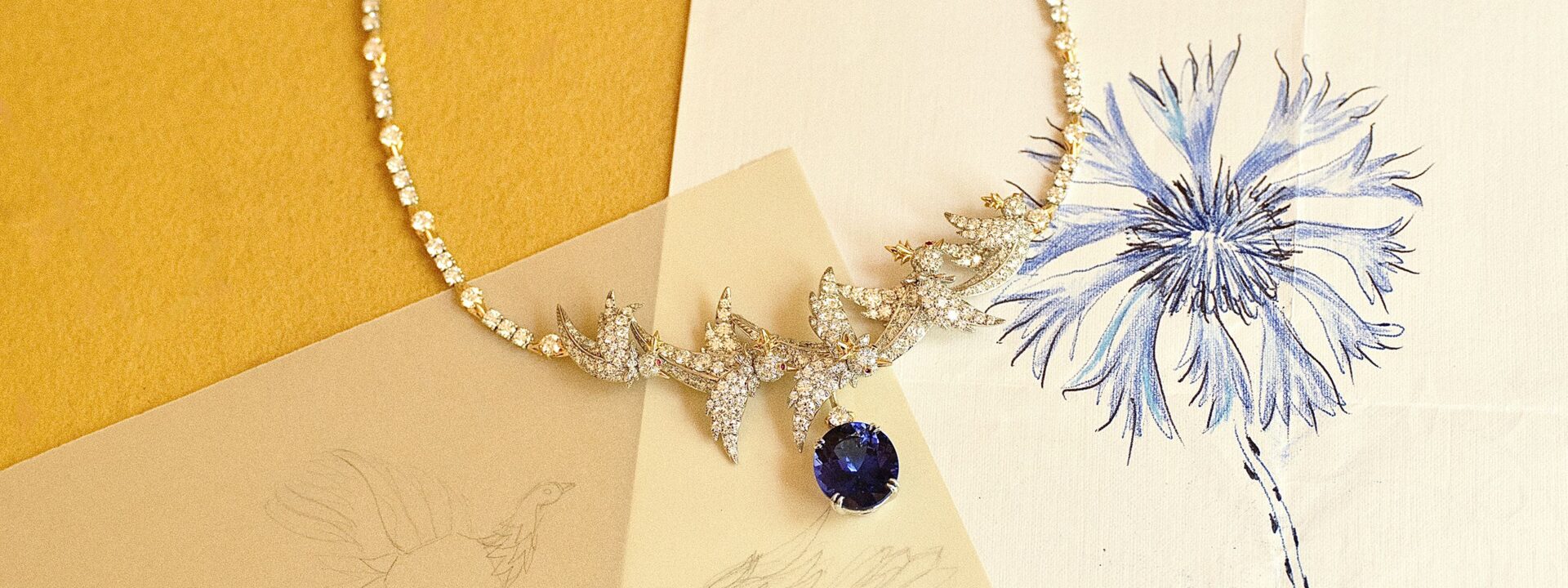On a cool, damp afternoon in mid-June, just after a morning of rain showers, I found myself following Lauren Santo Domingo through Central Park in search of rare birds.
“Our family got really into bird-watching during COVID,” says Santo Domingo, the cofounder of Moda Operandi and, since 2023, the artistic director of Tiffany & Co.’s home collection. (She’s not alone in her fascination—birds have been a recurring theme in fashion, from Thom Browne’s 2,000 paper cranes in his fall 2025 show to feathered accents at Marni, Luar, and Undercover.)
“My son especially became great at identifying them—males, females, all that,” she adds.
As we walk from the Ramble into Tupelo Meadow, where an ancient tupelo tree stands (one of the few predating Central Park itself), we spot our first bird. Desiree Rodriguez St-Plice, our guide from the Central Park Conservancy, identifies it as a white-throated sparrow. “They’re usually up north by now—this one must have stayed behind,” she says. “You probably know migration season just ended”—we didn’t—”so now they’re nesting and mating.”
High in the same tupelo tree, we see what Santo Domingo and I would vaguely call a “tiny speckled bird,” but Rodriguez St-Plice recognizes it as a European starling—a species introduced to the park in 1890 by a Shakespeare fan inspired by the bird’s mention in Henry IV. Moments later, a bright blue jay appears as we round a bend.
Out of the 200+ bird species that frequent Central Park (a prime spot on the Atlantic Flyway, the East Coast’s avian highway), we only managed to spot these three—plus plenty of pigeons, which Rodriguez St-Plice notes are technically called rock doves (to Santo Domingo’s relief). Still, sometimes one bird is enough.
“It really can brighten your day,” Rodriguez St-Plice says, “just seeing one little bird.”
While rare birds in Central Park might be hard to find, Tiffany & Co.’s newly redesigned 10th-floor headquarters at 57th and Fifth offers another way to appreciate them. There, Santo Domingo—wearing a trench from The Row, a COS shirt, Frankie Shop pants, and carrying a vintage Bottega bag—and I meet Nathalie Verdeille, Tiffany’s chief artistic officer of jewelry. Dressed in a black men’s blazer and sparkly-striped Lanvin pants from Alber Elbaz’s era, Verdeille walks us through her new Bird on a Rock collection—or rather, collections.
The original Bird on a Rock design, inspired by a yellow cockatoo that Tiffany’s legendary designer Jean Schlumberger spotted near his home in Guadeloupe, debuted in 1965 as a brooch. Bunny Mellon owned one of the first pieces, featuring lapis lazuli with yellow and white diamonds. Verdeille’s update expands the concept into two dazzling lines: high jewelry pieces centered on tanzanite (a necklace, bracelet, and earrings) and turquoise (a bold necklace with a diamond bird clutching strands of turquoise, plus a pendant, brooch, and ring)—both stones deeply tied to Tiffany’s history.
ROCK OF AGES
Jean Schlumberger’s Bird on a Rock designs showcased massive gems like citrine, aquamarine, tanzanite, and tourmaline. (Undated photo from The Tiffany Archives.)
Meanwhile, the fine jewelry collection… (text continues)The collection features rings, earrings (which can be worn in four distinct ways), bracelets, and necklaces with vibrant textures inspired by a bird’s plumage. The birds themselves take center stage in the necklaces, shimmering with life. When stacked, the rings interlock like the feathers on a bird’s wing. Both collections launch on September 2.
Unlike Santo Domingo and me, Verdeille—who trained at Paris’s prestigious Haute École de Joaillerie before working at Cartier, Chaumet, and, since 2021, Tiffany—didn’t wander through Central Park for inspiration. Instead, she explored Tiffany’s vast archives, drawing particular inspiration from Schlumberger’s yellow cockatoo.
“He was—what’s the bird that collects things? A magpie,” Santo Domingo says. “He traveled the world seeking new techniques, materials, and craftsmanship, gathering beautiful things along the way.”
“We wanted to capture the feeling of flight,” Verdeille explains, “so the bird seems to soar. The entire collection comes together like poetry.”
Each bird she designed required different diamonds—varying in size, shape, and color—with some pieces featuring 20 to 30 stones on the head alone. (The tanzanite necklace, for example, holds 594 diamonds and took nearly 350 hours to create.) “Every piece transforms depending on how you wear it,” Verdeille says. “It adds a new dimension.”
Beyond reimagining Schlumberger’s legacy, Verdeille aimed to redefine Tiffany itself. “How can we honor the past while propelling the bird—and the brand—forward?” she asked. The answer lay in movement and fluidity.
“Traditionally, Parisian jewelers studied animals in zoos to capture their motion,” Verdeille notes. “That’s how we crafted this new bird—its wings, its tail.” But in her innovative approach, she questioned: Why limit it to a cockatoo—or even a bird at all?
“Before settling on the cockatoo,” Verdeille admits, “we explored owls, peacocks, and even… how do you say? Pigeons.”
“Rock dove,” Santo Domingo suggests with a smile, “sounds so much more elegant.”
